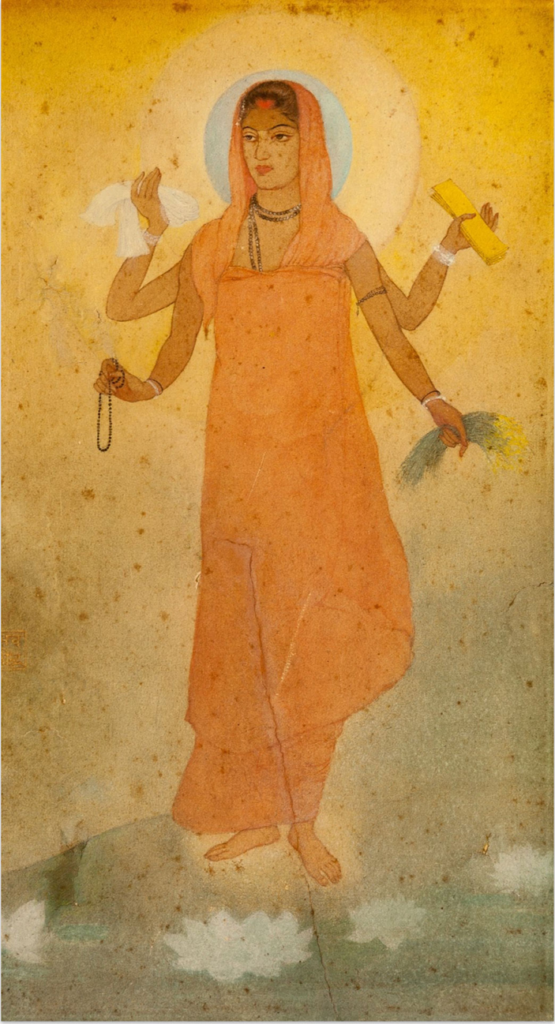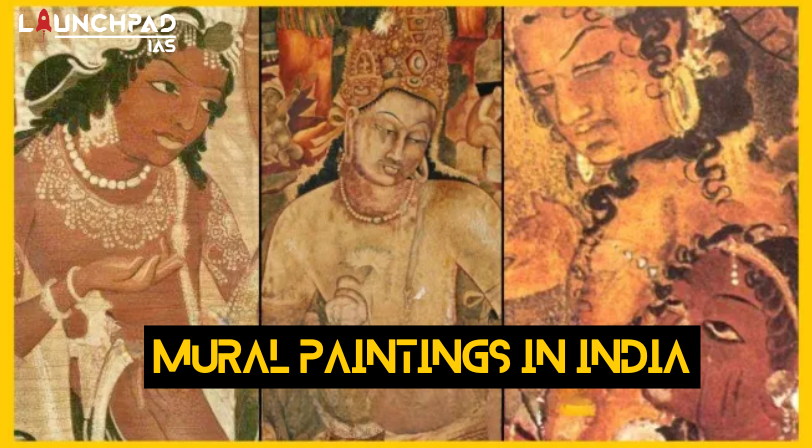- The works on the walls or a solid structure are referred to as Murals. These have existed in India since ancient times and can be dated between the 10th century BC and the 10th century AD.
- The Mural paintings are unique because of their sheer size. They cannot be contained on paper and need to be executed on the walls of large structures, usually caves and temple walls.
- In the ancient period, these were utilized by three major religions: Buddhism, Jainism, and Hinduism. Some of the best examples of mural paintings are:
Ajanta Cave Paintings
- Ajanta caves were carved in the 4th century AD out of volcanic rocks. It consists of a set of 30 caves, carved in a horse-shoe shape. These caves are quite popular for their exquisite mural paintings that took around four to five centuries to complete under the reign of the Mauryan Empire.
- Murals in cave no. 9 and 10 belong to the Sunga period, while the rest belong to the Gupta period. The walls of the caves have both murals and fresco paintings (painted on wet plaster). They use tempera style, i.e. use of pigments.
- The common themes of these paintings range from Jataka stories to the life of Buddha to elaborate decorative patterns of flora and fauna.
Ellora Cave Paintings
- The mural paintings in the Ellora caves are found in five caves, mostly limited to the Kailasa temple. These murals were done in two phases.
- The first phase paintings were done during the carving of the caves, while the second phase ones were done several centuries later.
- The earlier paintings show Vishnu with his consort Lakshmi borne through the clouds by Garuda, the celestial bird. The later paintings, made in Gujarati style, depict the procession of Shaiva holy men.
Armamalai Cave Paintings
- Armamalai Cave Paintings are situated in the Vellore district of Tamil Nadu, these natural caves were converted into a Jain temple in the 8th century. Unbaked mud structures are located within the cave, which acts like a place of rest for Jain saints.
- The beautiful colorful paintings on the walls and roof depict the tales of Astathik Palakas (deities protecting eight corners) and Jainism.
Jogimara Cave Paintings
- Jogimara Cave Paintings is an artificially carved-out cave located in the Surguja district of Chattisgarh. It is dated back around 1000-300 BC and has a few paintings and inscriptions of a love story in Brahmi script.
- The cave is said to be an attachment to the amphitheatre and paintings were made to decorate the room.
Miniature Paintings
- The word ‘miniature’ is derived from the Latin word ‘Minium’, which means red lead paint. This painting was used in illuminated manuscripts during the Renaissance period.
- It is generally confused with the word minimum, which would mean that they were small in size. The Indian subcontinent has long traditions of these miniature paintings and many schools developed that have differences in composition and perspective. Miniatures are small and detailed paintings.
- The painting should not be larger than 25 square inches. The subject of the painting should be painted in not more than 1/6th of the actual size.
- They usually have bulging eyes, pointed nose,s and slim waist.
Early Miniature
Early miniature paintings were initially less refined, featuring minimal decoration. Over time, they evolved to include more detailed embellishments, ultimately becoming similar to today’s miniature paintings—representing simply the early phase of this art form.
They were often painted for either books or albums, on perishable material including paper, palm leaves and cloth. These paintings developed between the 8th and 12th centuries and can be attributed to the eastern and western regions. Two prominent schools of early miniature paintings are:
Pala School of Art
This school was flourishing during 750-1150 AD. These paintings are generally found as a part of Buddhist manuscripts and were generally executed on palm leaf or vellum paper.
- These paintings are characterised by sinuous lines and subdued tones of the background imagery. There are lonely single figures in the paintings and one rarely finds group paintings.
- The proponents of the Vajrayana school of Buddhism also used and patronised these paintings.
Apabhramsa School of Art
- This school traces its origin to Gujarat and Mewar region in Rajasthan. It was the predominant school of painting in western India during 11th to 15th century.
- The most common themes of these paintings were Jain and in the later period, the Vaishnava School appropriated them too.

Transition Period Miniature
The coming of the Muslims on the Indian subcontinent was a sign of change and brought forth a cultural renaissance in the 14th century.

Miniature Art During Delhi Sultanate
- These paintings tried to bring together the Persian elements of their origins with the Indian traditional elements.
- The finest example from this period is the Nimatnama (a book on cookery) during the reign of Nasir Shah who ruled over Mandu.

Mughal Era Miniature Painting
The paintings made in the Mughal period had a distinctive style as they were drawn from Persian antecedents.
- There was a change in colour palette, themes and forms. The focus shifted from depicting the god to glorifying the ruler and showing his life.
- They focused on hunting scenes, historical events and other court related paintings.
- The painters were supposed to concentrate on ensuring the accuracy of line drawings. Except for religious paintings, the Mughals were known for their diverse themes.
- They brought the technique of foreshortening to the Indian painter’s repertoire. Under this technique, “objects were drawn in a way that they look closer and smaller than they really are.”
Miniatures in South India
The trend of making miniature paintings in the South Indian states is different from the north Indian schools owing to the heavy use of gold in these paintings. Furthermore, they concentrated on painting divine creatures much more than painting the rulers who patronized them. Some of the major schools are:
Tanjore Paintings
- The Thanjavur or Tanjore School is famous for the special style of decorative paintings. The Maratha rulers patronized them during the 18th century.
- These paintings are unique as they are mostly created on glass and board instead of cloth and vellum preferred in north India. Use of brilliant colour patterns and the liberal use of gold leaf are uniqueness of these paintings.
- They used many types of gemstones and cut glasses for embellishments to create larger than life images.
- These paintings reached their zenith under the patronage of Sarfoji Maharaj who was a great patron of arts.

Mysore Paintings
These paintings were patronised by the rulers of the Mysore province and continued in the British period too.
- The major theme of the Mysore paintings is the depiction of Hindu gods and goddesses. The unique part of these paintings is that they had two or more figures in each painting and one figure predominates all the others in size and colour.
- These paintings use the technique of the ‘gesso paste’, which is a mixture of zinc oxide and Arabic gum. This gives a particular base to the painting that develops sheen on the background.
- They counter it with the use of muted colours that are not so bright so as to counteract the background.

Modern Paintings
- Company Paintings: In the colonial period, a hybrid style of painting emerged that combined the elements of Rajput, Mughal and other Indian styles of painting with European elements (styles and techniques).
- These paintings evolved when the British Company officers employed painters who had been trained in Indian styles. Hence, they mixed their employers European tastes with their Indian training. This was called the ‘Company Paintings’.
- They were distinguished by the use of water colour and in technique by the appearance of linear perspective and shading.
- Lord Impey and Marquess Wellesley patronised the painters; several painters were engaged in painting the ‘exotic’ flora and fauna of India.

- Bazaar Paintings: This school was also influenced by the European encounter in India. They were different from the Company paintings as that school mixed European techniques and themes with Indian ones.
- The Bazaar school did not take any Indian influence but took the Roman and Greek influence. They made the painters to copy the Greek and Roman statues.
- This school was prevalent in the Bengal and Bihar region. A part from the Greco-roman heritage, they made paintings on everyday bazaar that showed Indian bazaars with European background.
- One of the most famous genres was of depicting Indian courtesans dancing before the British officials. They also painted religious themes but the figures of Indian Gods and Goddesses with more than two axes and elephant faces like that of Lord Ganesha were prohibited as they deviated from the European notion of natural human figurine.

- Bengal School of Art: The Bengal school is supposed to have a reactionary approach to the existing styles of paintings in the 1940s –1960s. This school is unique as they use simple colours.
- The idea of the Bengal school came up with the works of Abhanindranath Tagore in the early 20th century. He tried to incorporate Swadeshi values in Indian art and tried to reduce the influence of Western art style among artists.
- He is known for his painting Bharat Mata and various Mughal-themed paintings.
- The other notable painter of this school is Nandlal Bose. He was also entrusted with the task of illuminating the original document of the Constitution of India.
- Rabindranath Tagore was associated with this school. His paintings are unique as they use dominant black lines that make the subject look very prominent. He made small-sized paintings.

- Cubist Style of Painting: The cubist movement of Painting took its inspiration from the European Cubist movement.
- Under this style, the objects were broken, analysed and then reassembled. The artist reconstructed this process on the canvas through the use of abstract art forms.
- They tried to achieve the perfect balance between line and colour.
- One of the most popular cubist artists in India was M.F Hussain, who made a series of paintings called the ‘Personification of Romance’.



